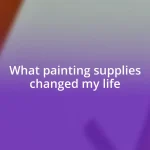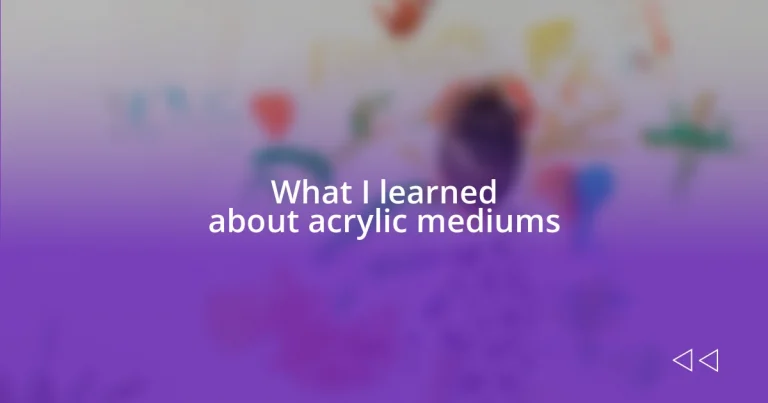Key takeaways:
- Acrylic mediums, such as gloss and matte, enhance color vibrancy and finish, allowing for diverse artistic expressions.
- Techniques like layering and using a retarder medium can improve blending and texture, elevating the overall quality of artwork.
- Common mistakes to avoid include using too much medium, overlooking drying times, and neglecting brush clean-up, which can impact the final outcome of the piece.
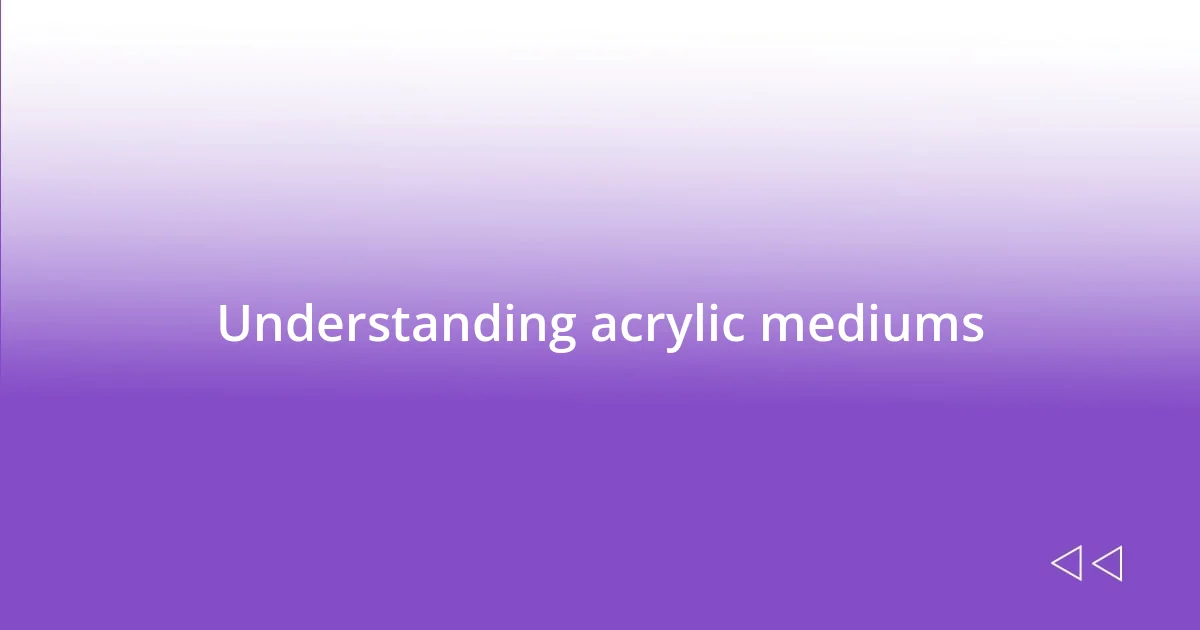
Understanding acrylic mediums
Acrylic mediums are fascinating because they can transform basic acrylic paint into something truly extraordinary. I remember my first experiment with a gloss medium, hoping to create a radiant finish on my canvas. The moment I mixed it in, I was captivated by how it enlarged the vibrancy of colors, giving my artwork a luminosity I had never achieved before.
What really intrigues me is the sheer variety of acrylic mediums available—each catering to different artistic needs. For instance, have you ever tried using a heavy gel medium? It offers remarkable texture and can even be sculpted while wet. I had so much fun with this when creating a mixed-media piece, layering it to give depth, and watching how light interacted with the ridges. It was a learning moment for me, realizing how acrylic mediums can shape not just the aesthetics but the very feel of the artwork.
Another interesting aspect is their drying time, which can actually work to your advantage. I recall a session where I mixed a retarder medium into my paint to extend the drying time. It allowed me to blend colors seamlessly on the canvas, creating soft transitions that would have otherwise dried too quickly. It got me thinking—how often do we overlook the little tools in our creative toolkit that can enhance our process and outcomes?
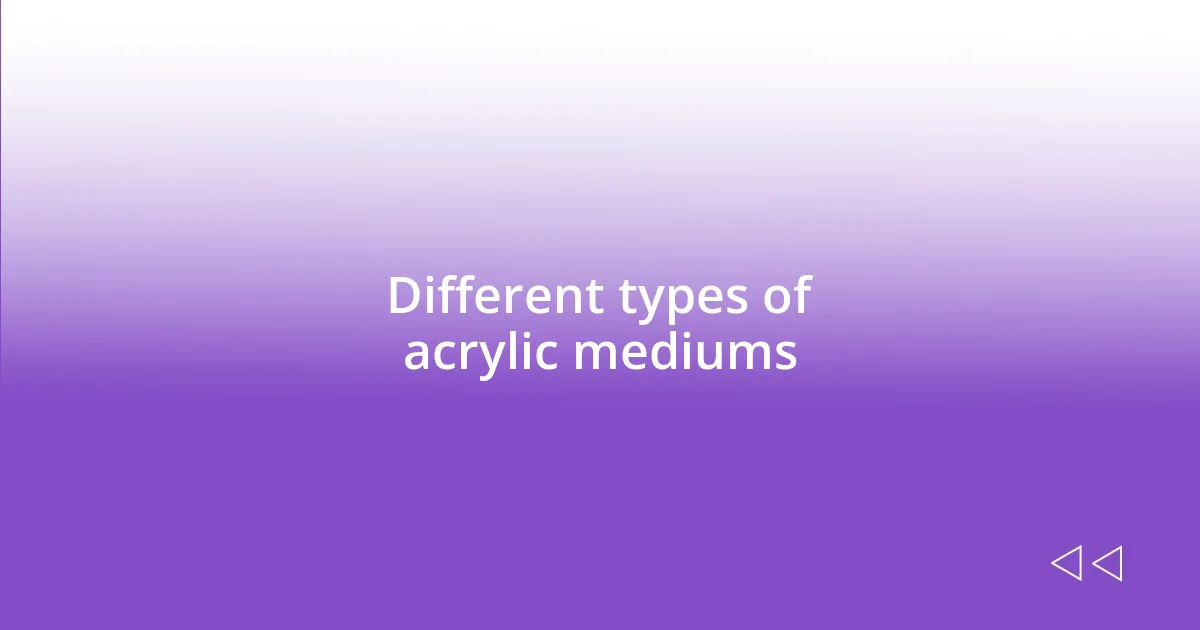
Different types of acrylic mediums
When I dive into the world of acrylic mediums, I’m always surprised by how they can completely change what I thought I knew about painting. For example, there’s the matte medium, which gives a beautiful, non-reflective finish. There was this one time when I was working on a gritty urban scene, and using a matte medium made my colors look richer without any distracting shine. I felt like I was finally capturing the essence of that city vibe.
Here are some different types of acrylic mediums to explore:
- Gloss Medium: Enhances vibrancy and provides a shiny finish, perfect for brightening colors.
- Matte Medium: Creates a subtle, non-reflective surface, ideal for achieving depth.
- Heavy Gel Medium: Adds substantial thickness and texture, allowing for sculptural elements.
- Retarder Medium: Prolongs drying time, facilitating smoother blending and transitions.
- Fluid Medium: Increases transparency and flow without altering paint consistency significantly.
Every medium offers unique opportunities for expression, allowing my creativity to blossom. And trust me, experimenting with them is not just enlightening; it’s borderline addictive!
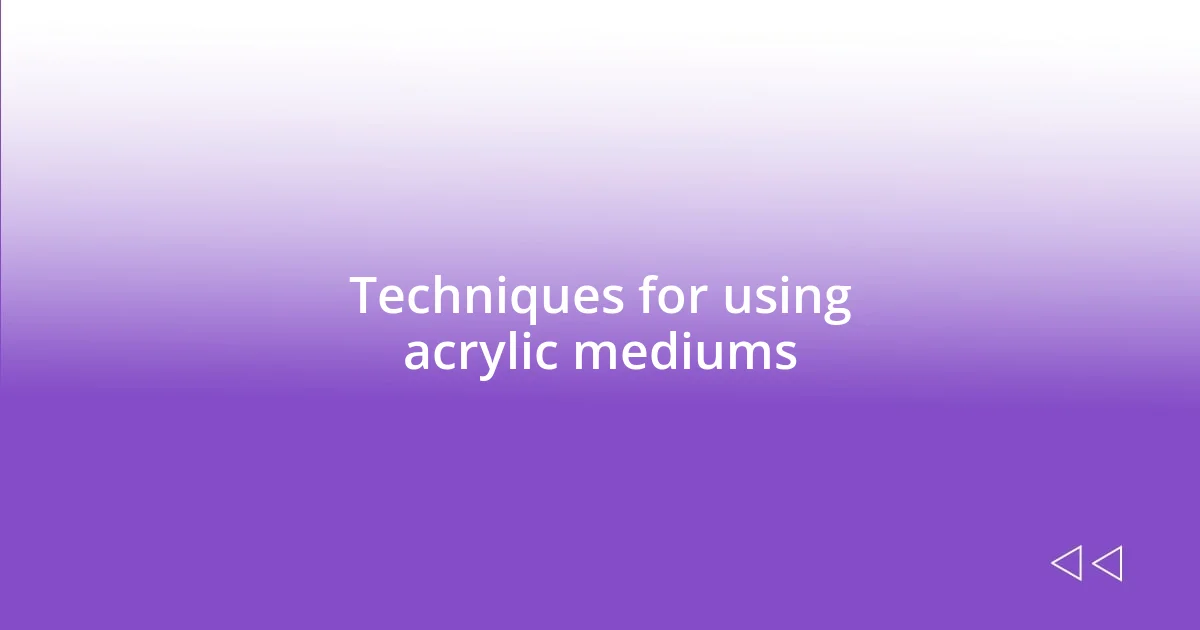
Techniques for using acrylic mediums
There are several techniques for using acrylic mediums that can really elevate your painting experience. One technique that I find incredibly effective is layering. When I layered a gloss medium over a drying piece, it created a stunning depth in my colors—you could almost feel the layers. The gloss medium didn’t just sit on top; it melded with the underlying paint, creating a captivating visual effect. Have you ever tried layering? It might surprise you how it adds complexity to your artwork.
Another technique I cherish is incorporating dry brushing with a heavy gel medium. I remember my excitement when I first tried this—it was like unleashing a new dimension to my art. By applying a thick layer of gel, I could gently drag a brush across it once dry. This technique allowed me to highlight textures and create unique patterns that genuinely brought my work to life. I think it’s safe to say that experimenting with various techniques yields rewarding results.
One of my favorite practices is mixing colors directly with a retarder medium before applying them to the canvas. This approach not only extends drying time but opens up a world of soft blends. I genuinely appreciate how this method can bring a gentle, harmonious feeling to an otherwise bold piece, allowing colors to interact gracefully without harsh lines. Have you explored any techniques that changed the way you paint? You might discover a newfound passion in each stroke.
| Technique | Description |
|---|---|
| Layering | Applying mediums in layers for depth and visual interest. |
| Dry Brushing | Using a dry brush technique over gel mediums to reveal texture. |
| Mixing with Retarder | Enhances blending by extending drying time for smoother transitions. |

Common mistakes to avoid
One common mistake I see many artists make is applying too much medium without testing it first. I remember the first time I slathered on a heavy gel medium—I thought it would give me the bold texture I craved. Instead, it turned into a sticky mess that completely overpowered my artwork. It taught me to always experiment on a scrap piece or in my sketchbook before committing to a big canvas. Have you ever made a similar blunder? I know I have!
Another pitfall is neglecting to consider the drying time of different mediums. In my early days, I got so wrapped up in layering colors and mediums that I lost track of how long they were taking to dry. Once, I tried to blend a fresh layer of paint on top of a semi-dry gloss medium, and the chaos that followed was nothing short of maddening! Each layer started to lift, creating unintended patterns. Staying aware of the drying times can save you from unexpected surprises and help maintain the integrity of your work.
Lastly, artists often forget to clean their brushes and tools promptly after working with acrylic mediums. I learned this the hard way when I found my once-beloved brushes ruined by dried paint and medium. It’s a painful reminder that these materials can be unforgiving. I swear by quick clean-ups; it’s a small step that makes a huge difference in maintaining my tools and preventing unwanted texture in my next masterpiece. How about you? Do you have a routine that ensures you take care of your equipment? I think it can make your creative life much smoother.
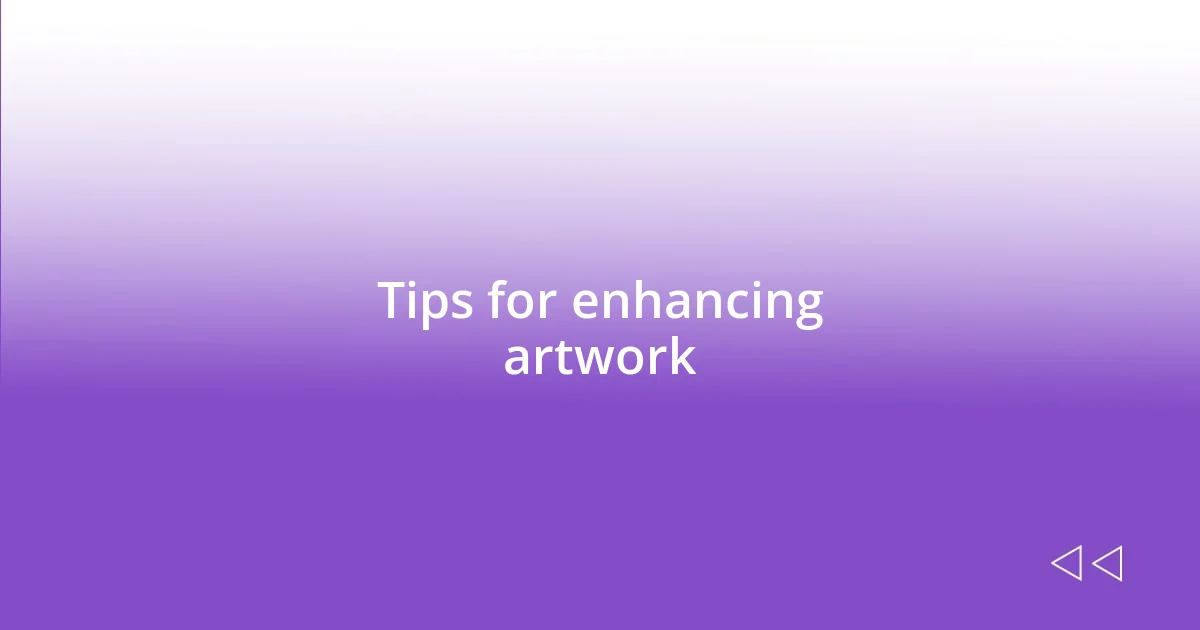
Tips for enhancing artwork
When I want to enhance my artwork, I often turn to the technique of glazing. For instance, I once used a transparent glazing medium over a vibrant sunset landscape I had painted. The effect was magical; it deepened the colors and added an ethereal glow without obscuring the underlying brushwork. Have you ever experimented with glazing? It’s like putting on a magical filter that transforms the whole piece.
Another tip I swear by is playing with the viscosity of my paint. I recall a time when I used a fluid medium to create a watercolor-like effect on a canvas. It allowed the colors to flow and blend beautifully on the surface, giving my artwork a light and airy feeling. I couldn’t believe how just adjusting the paint’s thickness could so dramatically alter the mood of my piece! Have you tried adjusting your paint’s viscosity? You might unlock a whole new realm of creative possibility.
Don’t overlook the importance of surface texture, either. I remember using a rough texture gel on a cityscape painting, and it brought an unexpected life to the buildings. The rough surface caught light in unique ways, making the city appear dynamic and vibrant. It’s incredible how something as simple as texture can completely shift the viewer’s experience. Have you considered how the surface of your canvas affects your work? It’s often the details that create the most lasting impressions.



